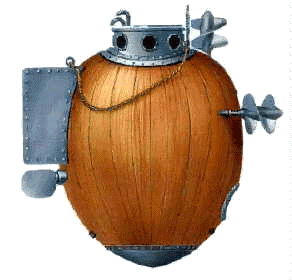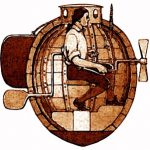british ship
 When most of us think of submarines, we think of the modern day nuclear subs that are basically underwater mobile cities, but as we all know, submarines have been around a lot longer…just how long was a surprise to me, although a learned history buff might not have been shocked at all. The idea of being able to operate underwater, actually dates back to ancient times when people used a hollow stick to breathe underwater. I’m not sure how successful any of those early attempts were, especially in the use of a vehicle of some kind, but probably not successful enough to warrant any kind of mass production.
When most of us think of submarines, we think of the modern day nuclear subs that are basically underwater mobile cities, but as we all know, submarines have been around a lot longer…just how long was a surprise to me, although a learned history buff might not have been shocked at all. The idea of being able to operate underwater, actually dates back to ancient times when people used a hollow stick to breathe underwater. I’m not sure how successful any of those early attempts were, especially in the use of a vehicle of some kind, but probably not successful enough to warrant any kind of mass production.
The first documented record of a submarine being used in combat, came as quite a surprise to me. The submarine, named Turtle, but usually called American Turtle, was used during the American Revolutionary War in 1776. Turtle was built in Old Saybrook, Connecticut in 1775 by American, David Bushnell as a means of attaching explosive charges to ships in a harbor. Turtle was designed  for use against British Royal Navy vessels occupying North American harbors. Then Connecticut governor, Jonathan Trumbull recommended the invention to George Washington. Even though Washington had his doubts, he provided funds and support for the submarine’s development and testing.
for use against British Royal Navy vessels occupying North American harbors. Then Connecticut governor, Jonathan Trumbull recommended the invention to George Washington. Even though Washington had his doubts, he provided funds and support for the submarine’s development and testing.
By 1776, Turtle was ready for testing. Several attempts were made by submarine operator, Sergeant Ezra Lee to affix explosives to the undersides of British warship HMS Eagle on September 7, 1776 in New York Harbor. Unfortunately, all of them failed, and Turtle’s transport ship was sunk later that year by the British…with Turtle aboard. Bushnell claimed to have recovered Turtle, but that has not been proven. Replicas of Turtle have been built and they are on display at the Connecticut River Museum, the U.S. Navy’s Submarine Force Library and Museum, the Royal Navy Submarine Museum and the  Oceanographic Museum in Monaco.
Oceanographic Museum in Monaco.
While Turtle was not successful, it was innovative, and it inspired other inventors to come up with ways that a submarine could be successful in combat, as well as exploration. I have to wonder if David Bushnell, or any of the other early inventors of crafts that operated under water had any idea how far below the surface of the oceans the submarine would eventually be able to go. Think of all the ships and planes that would never have been located, if we had no way to peer beneath the surface, and how much cargo would never have been recovered if we could not travel far below to not only locate, but salvage the cargo lost at sea. The submarine is truly amazing.

